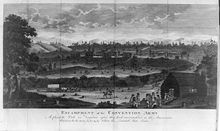Convention Army

The captured British and Allied troops of the Saratoga campaign after the Battle of Saratoga in the American War of Independence were referred to as the Convention Army (1777–1783) .
On October 17, 1777, the British General John Burgoyne negotiated with the American General Horatio Gates the terms of surrender for his remaining forces from the Saratoga campaign. The conditions were in agreement Saratoga ( Convention of Saratoga held) and stipulated that the army would be sent back to Europe when the parole would be not to fight again in North America. Gates sent a total of more than 5,800 British, Brunswick-Wolfenbüttel and Canadian troops to Boston .
The Continental Congress ordered Burgoyne to provide a list and description of all officers to ensure they would not return. When Burgoyne refused, Congress annulled the terms of the agreement. In November 1778, the Convention Army had marched 1,127 kilometers south to Charlottesville ( Virginia ) and was held here in short-term barracks ( Albemarle Barracks , named after Albemarle County , the area around Charlottesville) until 1781. During this time the Convention Army was an important economic factor in the region (especially in the Blue Ridge area).
The Virginia troops posted to guard were generally better fed and equipped than other North American troops, so that the prisoners' letters referred to a strong army. Money sent from the families of the prisoners from Britain and Germany provided hard currency for the rural Charlottesville area. Among the prisoners were high-ranking officers, in some cases their wives and children (e.g. Major General Friedrich Adolf Riedesel ). During the internment in Charlottesville you were welcome guests at social events. B. invited by Thomas Jefferson .
1781, started as the British forces military initiatives in Virginia, the Convention Army was moved again, and north to Lancaster ( Pennsylvania transferred). Apart from a few exchanged officers, the prisoners remained interned until 1783. When the war formally ended, those who had survived the forced marches and typhus were sent home.